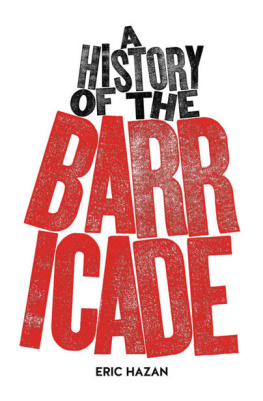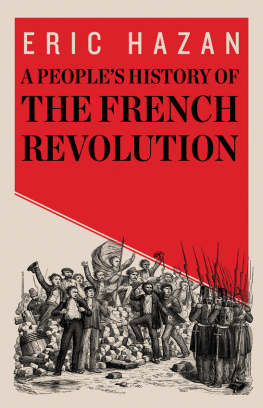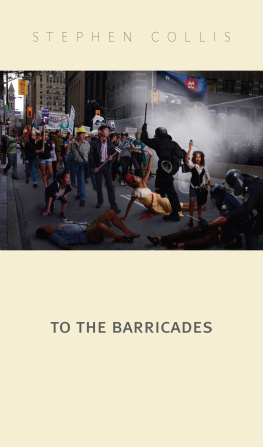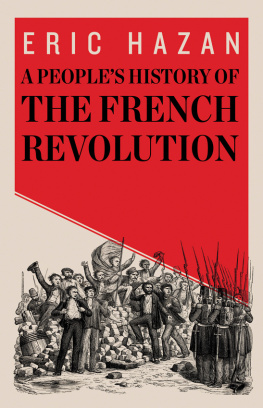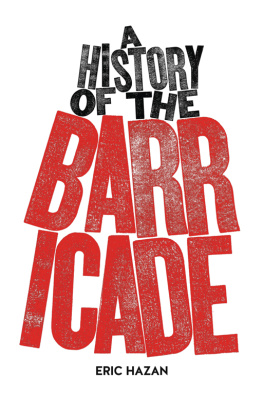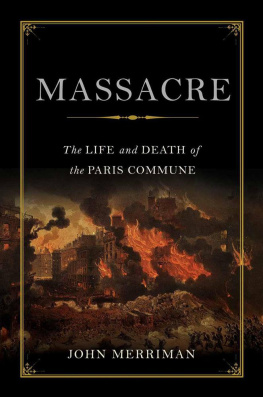For the rest, the barricades are retrenchments that belong to the Paris spirit: they are found in all our disturbances, from Charles V to our own day.
That streets should be used as battlefields is an idea perhaps as old as cities themselves. And since the very first urban combats, people no doubt tried to protect themselves by piling up whatever they had to hand: planks, rubble or carts. The barricade, however, is not a regular retrenchment. A heap of disparate objects, combined in a moment, its particular virtue is to proliferate and form a network that crosses the space of the city. This faculty of rapid multiplication can make it an offensive instrument: victorious barricades, as we shall see, are those that pin down the forces of repression, paralyse their movements and end up stifling them into impotence.
The history of the barricade stretches across three centuries. It starts at the height of the Wars of Religion, quickens in the course of the nineteenth century, and ends with the Bloody Week that marked the end of the Commune. (Its extensions in the twentieth century are almost a different story.) It takes place principally in Paris: a Parisian invention, the barricade is the common point of the majority of riots, insurrections and revolutions that punctuate the history of the city and the country with the sole exception of the French Revolution, in which its role was belated and minor. At certain points, moreover, it was copied elsewhere, as at Lyon in the 1830s or across Europe at the time of the springtime of the peoples in 1848.
Writing this history has not been easy: the barricade is intermittent by nature, which makes it impossible to set down a neat linear story. What I have tried here, however, is to show a certain continuity: in this symbolic form of popular revolt we find across the centuries the same material elements, or nearly so youngsters, stallholders, workers, students, defending their street, their district, their way of life against forces that are always superior in both numbers and weapons; and on the other side, Swiss guards in the service of kings, or peasants brought by rail from the depth of the provinces. Behind the paving-stones, rifles and flags, it is these heroes and heroines that I have tried to bring back to life from the anonymity into which official history has cast them.
We could say that this is only a succession of defeats some immediate, on the ground, others delayed in which the forces of domination end up reversing the gains of an ephemeral victory. But thanks to Baudelaire, Blanqui, Hugo and Lissagaray, this is a history that is still living, a source of inspiration for those unresigned to the perpetuation of the existing order.
Barricade: the word makes its first appearance in the Commentaires of Blaise de Monluc, the warlord who commanded the royal troops against the Huguenots in Guyenne in the 1570s. He had a certain personal experience of it. In September 1569, he attacked Mont-de-Marsan: The enemies fired straight at the bridge, along a main road, where they had put a barricade, which they were not all able to reach, as we caught a large force in the side roads. Finally the enemies abandoned the barricade and hastened into the other town by the gateway. (Mont-de-Marsan had three concentric walls, and this attack was directed against the outermost of these.) When the town was taken, Monluc had the garrison executed. In July 1570 he laid siege to Rabastens, a fortified bastide on the banks of the Tarn, the strongest castle that was in the power of the queen of Navarre:
I had three or four ladders brought to the edge of the ditch, and as I turned back, I was struck by an harquebusade from the corner of a barricade touching the tower: I believe there were not as many as four harquebusiers there, as all the rest of the barricade had been destroyed by two cannon firing from the flank. Suddenly I was covered in blood, flowing from my mouth, nose and eyes. But wiping the blood as best I could, I said to monsieur de Goas: Make sure, I pray you, that no one collapses, and continue the combat.
After the bastide was taken, Monluc still had the strength to order that not a single man escape without being killed. It was during his convalescence that he wrote his Commentaires, while the leather mask was being made that he would wear until his death to hide his destroyed face.
But Guyenne was a remote place, and the war waged by Monluc against Henri de Navarre is not a major chapter of history. The official birth of the barricades dates from some twenty years later: on 12 May 1588, the regular troops that Henri III had brought into Paris were hemmed in by the tight mesh of barricades erected by the population, and narrowly escaped massacre. This famous Day of the Barricades marked both a turning point in the Wars of Religion that had ravaged France for more than twenty-five years, and the first large-scale and effective use of this tactic, fixing for a long time to come both the practical modalities of its use and its political significance.
Henri III, who had previously been king of Poland, came to the throne of France in 1574 on the death of his brother Charles IX (the king of the St Bartholomew massacre). He was not popular, particularly in Paris, which at that time was very Catholic and traditional. His entourage was lampooned, the famous mignons who passed their time in duels and debauchery of various kinds. He was attacked for his fantasies, his cross-dressing, his taste for lapdogs and exotic animals. Pierre de LEstoile, gentleman usher to the chancellery and quite royalist in his sympathies, related in his diary that on 14 July 1576:

